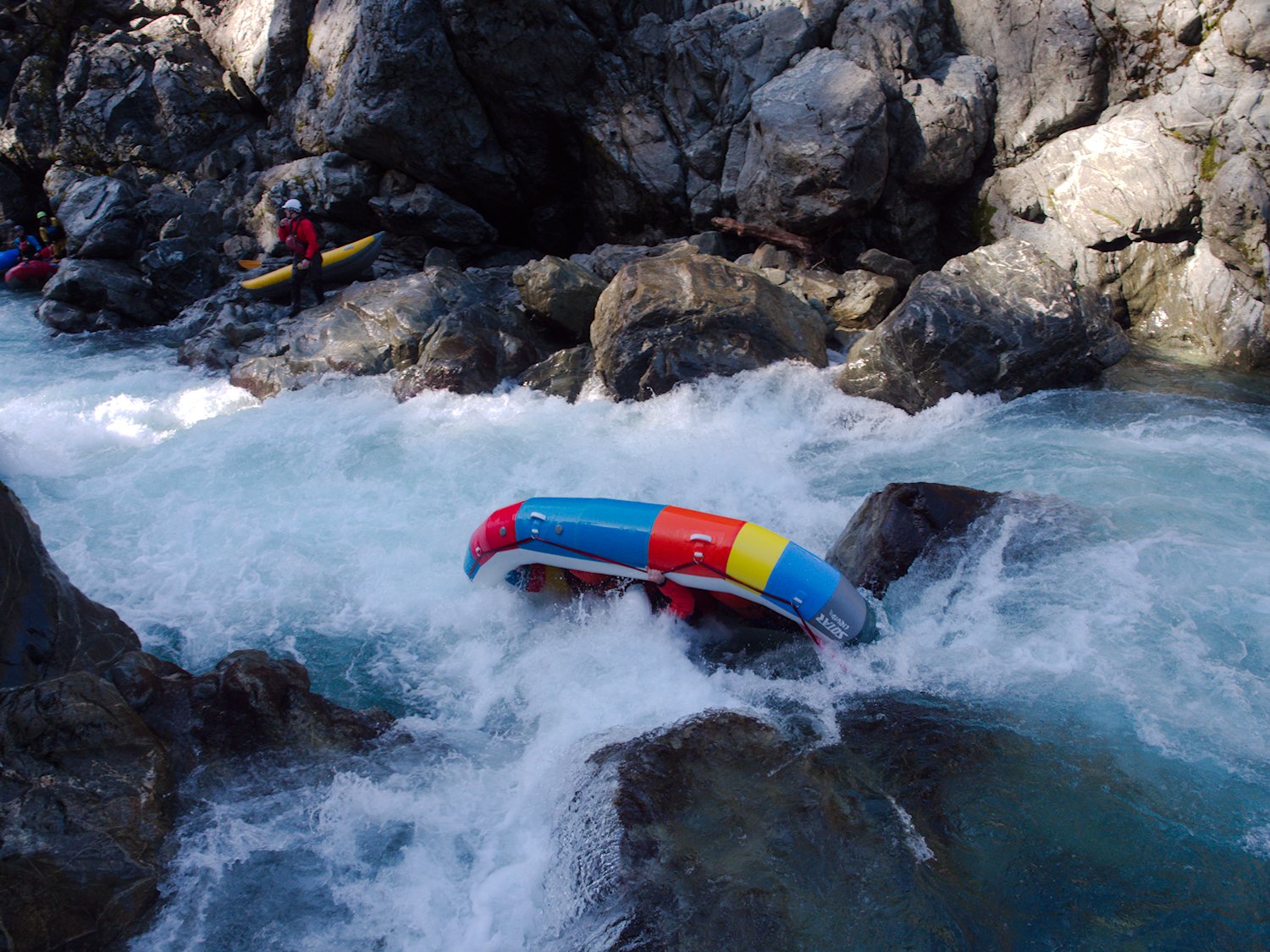When should you speak up for safety
Safety is a difficult topic in the outdoor adventure community, on the one hand we want our friends and family to return home at the end of the trip. On the other hand, we are engaged in an inherently risky activity. So, the big question is where is the middle ground between safety and acceptance of an increased risk profile? That is a discussion that every paddler needs to weigh with their risk profile, but at what point do we need to speak up for safety?
Risk tolerance
To get a good sense of a person’s risk tolerance you’re going to want to evaluate their risk profile. The risk profile is a framework that you can use to evaluate the level of risk that person is comfortable with. As you get to know someone you will better understand their risk profile, but there are some things you can do to help quickly establish a risk profile.
Remember that assessing someone's risk tolerance is not an exact science, and people's comfort levels can change over time and in different circumstances. We’re going to examine how to build a risk profile for the river in a later article, but for now we’re going to give you a simple way to do a quick evaluation.
Ask Open-Ended Risk Questions: Start by having a conversation with the person about their outdoor experience and comfort level. Ask open-ended questions to understand their background, any previous outdoor activities, and what they enjoy or find challenging.
Ask About Their Trust Metrics: Ask about what traits they feel makes another boater a trustworthy person. We have a million metrics for performance, but we discuss very few for trust.
What Else Have They Run: Ask about their past experience on rivers. Inquire about their comfort level with the current run, such as weather conditions, water level, or remoteness of the area. Have they been on the run before? Try to get them to discuss any challenging situations or emergencies they’ve encountered? How did they handle them?
Physical Fitness and Health: Assess their physical fitness and overall health. Outdoor activities including boating require a good level of physical fitness, and health issues may affect their risk tolerance.
Training and Skill Level: Evaluate their outdoor skills and training. Do they have the necessary skills, knowledge, and training for trip you're planning?
Observe Non-Verbal Cues: Pay attention to non-verbal cues, such as body language and reactions when discussing risky situations or scenarios. These can provide insights into their comfort level.
The key here is to assess your reaction to their answers. Do you find yourself agreeing with the way they like to conduct themselves in the outdoors? If you find yourself disagreeing with their statements think about why, but this can be a good indicator that your risk profiles may not align. You want to find people who align with your personal risk profile so finding like minded people can go a long way to your comfort with their attitude towards safety topics.
How accidents really happen
In our article on how accidents really happen we explore the idea that accidents are not a single catastrophe, but a series of minor safety issues that build up to create an accident. These safety issues are best represented as either red or yellow flags and each of these flags have different weight in terms of how likely they are to cause an accident. An untied shoe, for example, has a different impact on a scenario than a raft impacting a sharp piece of metal in a rapid.
A good way to think of red flags is that these are things, by themselves, have a high likelihood of negatively impacting an experience by stacking the odds against you. Practically speaking red flags are things like bad weather, potential for flashes in flows, new paddle partners, new boaters, and inadequate thermal protection.
Yellow flags are Minor safety concerns are in essence things that are generally annoying or inconvenient, but not in an of themselves life threatening. Examples of this would be a forgotten layer, forgetting your main paddle so you have to using a spare, or not having some extra electrolytes.
As part of this, understand that a good crew should be open to the idea that anyone can speak up for safety and that voice should cause your crew some pause for consideration. For more info on this take a look at our article on how accidents really happen.
When to speak up
Speaking up for safety is definitely a situational issue and is less a value statement. There is a lot of subjective factors that play into when people speak up. Events such as the loss of a friend, a recent accident, a debilitating injury, closeness to a potential victim of an accident, fight or flight response, acute fear, chronic anxiety and may other factors can make this process an emotional process rather than a logical process. The goal of this discussion though is to assess some objective and logical guidelines that can help you assess when you need to speak up.
Immediate Danger: If you or someone else is in immediate danger or at risk of injury, do not hesitate to speak up. In such situations, swift action is crucial. Alert others, call for help if needed, and take any necessary steps to ensure safety.
Potential Safety Issues: If you notice hazardous conditions in your environment, let the crew know. This can include anything from substance use to dangerous conditions like a slippery rock on a portage. You can use the red and yellow flag type language to alert others to how dangerous the situation might be.
Gut Feeling: If something doesn't feel right, or if you have a gut feeling that a situation is unsafe, speak up. New boaters especially may not have all the tools and mental models to articulate why something doesn’t feel right, but we all possess an instinct for spotting danger. It's better to be cautious and address potential risks early rather than ignoring your intuition.
Lack of Safety Equipment: If someone is not using or providing essential safety equipment, such as helmets, life jackets, or throw bags, it's crucial to raise this concern. Safety gear exists for a reason, and its proper use can prevent accidents.
Communication Breakdown: If you notice a breakdown in communication that could lead to confusion or dangerous situations, speak up to clarify instructions, plans, or expectations. Having accurate communication can be tough on the river so whistles and hand signals can go a long way to helping to clarify what people are saying. Take the time as well to clarify your signals before the trip so that folks are on the same page, because paddling signals can vary from region to region.
Unclear or Inadequate Planning: If you believe that the planning for a trip is inadequate or unclear, express your concerns. Everyone should understand the route, emergency procedures, and any potential risks associated with the trip. The burden of liability for the trip is on you as the participant even though a company or trip leader may be negligent you are the one who ultimately has to del with the consequences both in an accident and after.
Peer Pressure: Ego and bravado run rampant in the river and larger outdoor communities. It’s really easy to have a bunch of people pressure you into running a river that you’re not comfortable with. If this is the case, pump the breaks, and if the crew doesn’t respect your input, then that should be a serious red flag.
This is by no means a comprehensive list, but we break this down by examining number and of flags we can start to form a logical basis for how we want to address these issues. Ultimately you will have to decide on what your group’s risk profile looks like, but having a standard in mind can help you make better decisions to avoid accidents. It all comes down to speaking up when you see something that violates your objective standards. It can be as simple as stopping and letting everyone in the crew know you see a yellow or red flag and you are uncomfortable with the situation. At that point, ideally if you are with a good team, the team will take on the responsibility is to either mitigate or avoid that risk and factor that risk into the overall execution of the trip.
Speaking up may not always be easy, especially in large group social situations. A good tip is to use respectful and assertive communication when addressing safety concerns. You should be prepared to offer solutions or alternative courses of action when possible or let the crew know that you don’t have the tools available to properly address the scenario. In many cases, speaking up can prevent accidents and help save lives, but ultimately the question comes down to how many red flags are you comfortable with?






